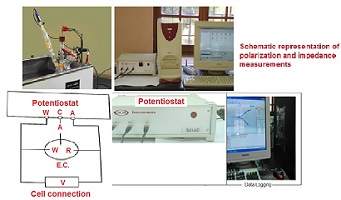

银纳米颗粒对铝金属在酸性介质中的耐蚀性能研究
收稿日期: 2016-04-27
修回日期: 2017-01-03
网络出版日期: 2017-01-04
基金资助
This work was supported by Faculty of Science, Alexandria University
An Electrochemical Investigation in the Anticorrosive Properties of Silver Nanoparticles for the Acidic Corrosion of Aluminium
Received date: 2016-04-27
Revised date: 2017-01-03
Online published: 2017-01-04
Supported by
This work was supported by Faculty of Science, Alexandria University

H. A. Fetouh , B.A. Abd-El-Nabey , Y.M. Goher , M. S. Karam . 银纳米颗粒对铝金属在酸性介质中的耐蚀性能研究[J]. 电化学, 2018 , 24(1) : 89 -100 . DOI: 10.13208/j.electrochem.160427
The mass loss, potentiodynamic polarization and electrochemical impedance spectroscopy (EIS) techniques were used for the determinations of the corrosion rates for aluminium in 1.0 mol·L-1 hydrochloric acid (HCl) solutions both in the absence and presence of silver nanoparticles (SNPs) at 30 ℃. The protection efficiency was evaluated to be 96.4% for 0.014 g·L-1 of the SNPs. It has been found that the capacity of the electrical double layer at the aluminium/solution interface was decreased with increasing the concentration of the SNPs, indicating that the SNPs were adsorbed at the aluminium surface. The Langmuir adsorption isotherm and the kinetic-thermodynamic model were fitted to the experimental data. The potential of zero charge (PZC) for aluminium was determined in order to clarify the type of interaction between the metal surface and the SNPs. The experimental data obtained by scanning electron microscopy (SEM) and energy-dispersive X-ray (EDX) spectroscopy, together with the visual inspections at the surfaces of the aluminium electrodes after the electrochemical tests, all gave very good support to those obtained by the mass loss and electrochemical measurements.

Key words: aluminium; silver nanoparticles; corrosion rate; electrochemical technique
/
| 〈 |
|
〉 |